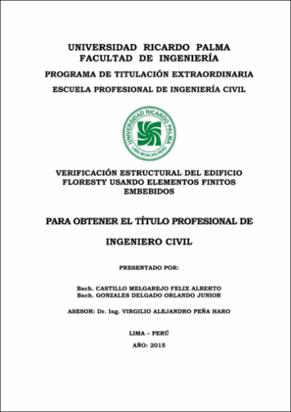Mostrar el registro sencillo del ítem
Verificación estructural del edificio Floresty usando elementos finitos embebidos
| dc.contributor.advisor | Peña Haro, Virgilio Alejandro | |
| dc.contributor.author | Castillo Melgarejo, Felix Alberto | |
| dc.contributor.author | Gonzales Delgado, Orlando Junior | |
| dc.date.accessioned | 2019-09-30T20:28:05Z | |
| dc.date.available | 2019-09-30T20:28:05Z | |
| dc.date.issued | 2015 | |
| dc.identifier.uri | https://hdl.handle.net/20.500.14138/2369 | |
| dc.description.abstract | Peru is a seismic country because it is near to a subduction zone where the Nazca Plate moves under the Continental Plate. In the denominated subduction zones, the plate accumulates a great amount of energy in getting into the other plate. These plates move forward to the contrary sense compressing themselves up to come to a break point of large volumes of rock generating earthquakes of great magnitude. In Lima, strong earthquakes have occurred according to records kept until now, and the most significant was that of 1746 where there were a lot of destruction and where many people died. In Peru, Reinforced Concrete E.060 and Earthquake Resistant Design E.030 Standards have developed in the National Construction Regulations. These standards are very important for designing and good building performance, which supports to the foundations, which is in charge of transferring the loads to the ground spreading these one so that it does not exceed allowable pressure. E.060 standard contains minimal values, which shall fulfill for structure performance with ACI momentum coefficient method. However, it is possible design with finite-element method using VisualFEA software and the results are obtained with this software shall fulfill the standard. The study area to analyze is within San Miguel District, Province and Department of Lima, where a multifamily apartment block is constructed, and we are interested in analyzing its foundation because it shows already a design given by projector; this design comes to be a pad foundation or foundation slab. It is from this item where we are going to start to proof it fulfills with ACI momentum coefficient method according to Peruvian Standard and it shapes with finite-element method through VisualFEA software whose results shall also fulfill. In this sense, the main objective would be comparison and demonstration of analysis results of building F’s foundation slab using finite-element method through VisualFEA software; these results shall fulfill the Construction E.60 Peruvian standard with the ACI momentum coefficients method. | es_ES |
| dc.description.uri | Tesis | es_ES |
| dc.format | application/pdf | es_ES |
| dc.language.iso | spa | es_ES |
| dc.publisher | Universidad Ricardo Palma | es_ES |
| dc.rights | info:eu-repo/semantics/openAccess | es_ES |
| dc.rights.uri | https://creativecommons.org/licenses/by-nc/4.0/ | es_ES |
| dc.source | Universidad Ricardo Palma | es_ES |
| dc.source | Repositorio institucional - URP | es_ES |
| dc.subject | VisualFEA | es_ES |
| dc.subject | MEF | es_ES |
| dc.subject | Results Seismic | es_ES |
| dc.subject | Shear | es_ES |
| dc.subject | Ductility Force y Zusc | es_ES |
| dc.title | Verificación estructural del edificio Floresty usando elementos finitos embebidos | es_ES |
| dc.type | info:eu-repo/semantics/bachelorThesis | es_ES |
| thesis.degree.discipline | Ingeniería Civil | es_ES |
| thesis.degree.grantor | Universidad Ricardo Palma. Facultad de Ingeniería | es_ES |
| thesis.degree.level | Título Profesional | es_ES |
| thesis.degree.program | Programa de Titulación Extraordinaria | es_ES |
| thesis.degree.name | Ingeniero Civil | es_ES |
| dc.publisher.country | PE |
Ficheros en el ítem
Este ítem aparece en la(s) siguiente(s) colección(ones)
-
Ingeniería Civil [944]


